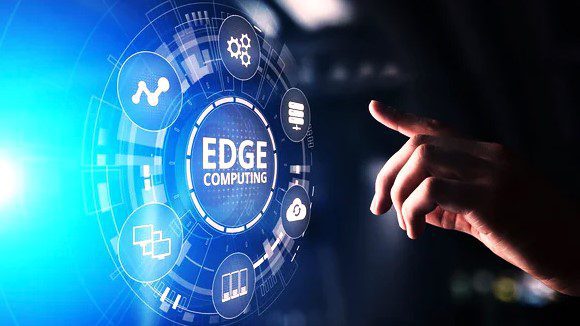In today’s rapidly evolving digital landscape, businesses are constantly looking for ways to improve user experiences, operational efficiency, and overall business performance. Edge Computing is one technology that has grown significantly in popularity in recent years. The way we approach computing and data management has been completely transformed by edge computing’s capacity to move data processing closer to the data source. We will delve into edge computing in this article, looking at its advantages, applications, and potential to change the course of Infrastructure Technology.

Contents
Understanding Edge Computing
What is Edge Computing?
Edge computing, also known as the Internet of Things (IoT) or edge servers, is fundamentally a decentralized computing paradigm that moves computation and data storage closer to the point of need. Edge computing allows for real-time data analysis and processing at the edge of the network, in contrast to traditional cloud computing, which processes data in distant data centers. This proximity to the data source reduces latency, improves response times, and enhances overall system performance.
The Key Components of Edge Computing
Edge computing involves a network of interconnected devices and systems working collaboratively to process and analyze data. Let’s explore the key components that make up an ed-computing ecosystem:
1. Edge Devices
Edge devices are the endpoints where data is generated. These devices can range from sensors and actuators in IoT devices to smartphones and laptops. They collect and transmit data to edge servers for processing and analysis.
2. Edge Servers
Edge servers act as the intermediary between the edge devices and the cloud. They carry out analytics, data processing, and storage tasks locally, allowing for real-time insights and minimizing the need for data to travel back and forth between the cloud and edge devices.
3. Edge Data Centers
Edge data centers are decentralized facilities located closer to edge devices and users. They house the necessary infrastructure to support ed-computing, including servers, storage systems, and networking equipment. For local data processing, edge data centers guarantee high-bandwidth, low-latency connections.
Benefits of Edge Computing
The wide range of advantages that ed-computing provides makes it a desirable choice for companies in a variety of industries. Let’s describe some of the key advantages:
1. Reduced Latency
By processing data at the edge of the network, edge computing significantly reduces latency. This is especially important for real-time data analysis applications like augmented reality, industrial automation, and autonomous vehicles. The decreased latency improves system responsiveness and enhances user experiences.
2. Enhanced Data Privacy and Security
Ed-computing addresses the concerns surrounding data privacy and security. Since data processing occurs locally, sensitive information can be processed and stored closer to its source, minimizing the risk of unauthorized access or data breaches. This is especially important for industries like healthcare, finance, and government, where data privacy regulations are stringent.
3. Bandwidth Optimization
By leveraging edge computing, businesses can optimize their network bandwidth utilization. Instead of transmitting vast amounts of raw data to the cloud for processing, edge devices can perform initial data filtering and analysis, transmitting only the relevant insights to the cloud. This reduces network congestion and lowers operational costs associated with data transmission.
4. Offline Functionality
One of the notable advantages of ed-computing is its ability to operate offline or with limited connectivity. Since edge devices have localized processing capabilities, they can continue to function and make critical decisions even in scenarios where network connectivity is intermittent or unavailable. This is crucial for use cases like remote monitoring, disaster management, and autonomous systems.
Use Cases of Edge Computing
Ed-computing finds applications across a wide range of industries and domains. Let’s explore some prominent use cases where ed-computing is making a significant impact
1. Smart Cities
Ed-computing is essential for creating smart cities because it makes it possible to manage critical infrastructure and monitor it in real-time while also analyzing and managing data. From intelligent traffic management systems to efficient waste management and environmental monitoring, ed-computing enhances the efficiency and sustainability of urban environments.
2. Industrial Automation
Ed-computing empowers industrial automation by enabling real-time monitoring, predictive maintenance, and intelligent decision-making at the edge. Manufacturing facilities can leverage edge devices and analytics to optimize production processes, minimize downtime, and improve overall operational efficiency.
3. Healthcare
In the healthcare sector, ed-computing facilitates remote patient monitoring, real-time health data analysis, and faster diagnosis. Edge devices can collect and process patient data, allowing healthcare providers to deliver personalized care and timely interventions. Ed-computing also enables the secure sharing of medical data while ensuring compliance with data privacy regulations.
4. Retail
Ed-computing offers numerous possibilities in the retail industry, including personalized shopping experiences, inventory management, and supply chain optimization. By analyzing data at the edge, retailers can gain valuable insights into customer behavior, optimize product placement, and streamline logistics processes.
The Future of Edge Computing
Ed-computing is poised to become a crucial component of our digital infrastructure as technology advances. Ed-computing adoption is being fueled by the spread of IoT devices, improvements in 5G connectivity, and rising demand for real-time data analysis.
We can anticipate more developments in ed-computing architectures, the creation of specialized edge devices, and increased interaction between edge and cloud computing in the years to come. These developments will open up new avenues and make it possible for ed-computing to be seamlessly incorporated into our daily lives.
Conclusion
The way we process, examine, and use data is changing as a result of ed-computing. Ed-computing presents unrivaled opportunities for businesses to optimize their operations and provide exceptional user experiences thanks to its capacity to deliver low-latency processing, enhanced security, and improved bandwidth utilization. Organizations can unlock new frontiers of innovation and maintain a competitive edge in the hyperconnected world of today by utilizing the power of ed-computing.
Frequently Asked Question’s (FAQ’s)
Q.1: What is edge computing?
A distributed computing paradigm called edge computing moves data processing and analysis closer to the point of data generation. Instead of relying on a centralized cloud infrastructure, edge computing enables data processing to occur at or near the edge of the network, closer to where the data is being generated.
Q.2: Why is edge computing important?
Edge computing is important because it offers several benefits, including reduced latency, improved data privacy and security, bandwidth optimization, and enhanced real-time decision-making capabilities. By processing data closer to its source, edge computing can significantly reduce the time it takes for data to travel to a centralized cloud server and back, enabling faster response times and better user experiences.
Q.3: What are some use cases of edge computing?
Edge computing can be applied to various industries and use cases. There are some examples of include autonomous vehicles, industrial automation, smart cities, remote monitoring and surveillance, healthcare, retail, and Internet of Things (IoT) applications etc. In these scenarios, edge computing helps enable real-time processing, analysis, and decision-making, without relying heavily on cloud connectivity.
Q.4: What distinguishes edge computing from cloud computing?
Cloud computing involves centralizing data storage and processing in remote data centers, whereas edge computing distributes these capabilities closer to the data source. In cloud computing, data is typically sent to a central server for processing, while in edge computing, data processing occurs locally or in nearby edge devices. Edge computing provides faster response times, reduced bandwidth requirements, and enhanced privacy, but it may have limitations in terms of scalability and resource constraints compared to the virtually unlimited scalability of cloud computing.
Q.5: What are some challenges of edge computing?
Edge computing presents certain challenges, including limited computing resources in edge devices, network connectivity issues, security concerns, and managing a decentralized architecture. Edge devices often have constrained computational power and memory, which can impact the complexity of applications that can run on them. Ensuring reliable network connectivity and managing the security of distributed edge infrastructure can also be challenging.
Q.6: What technologies are commonly used in edge computing?
Edge computing leverages a combination of hardware and software technologies. Common technologies used in ed-computing include edge servers, edge gateways, edge devices, edge analytics software, machine learning algorithms, and IoT platforms. For enable data processing, analysis, and decision-making at the edge of the network these technologies are work together.
Q.7: Is edge computing replacing cloud computing?
Edge computing is not replacing cloud computing but rather complementing it. While ed-computing brings processing closer to the data source, cloud computing still plays a crucial role in providing centralized storage, advanced analytics, and managing large-scale data. Ed-computing and cloud computing can be used together in a hybrid architecture to optimize data processing and storage based on specific requirements and use cases.
